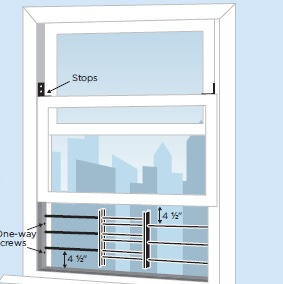An insider's guide to NYC's quirky rental laws
I spent the last few weekends of my ✨ nuclear summer ✨ finding a new place to live.
Along the way I discovered dozens of curios of rental law in NYC, ranging from regulations for heating and hot water to window guards and mirrors in elevators.
Solutions to problems that I didn’t even know could exist! These quirks blew my mind — who knew NYC rental laws were so peculiar?
But it made sense in this city of cultures mashed together1.
From fancy high-rises to crammed tenements, the battles of landlords, tenants, and the government have raged for centuries. It's a history of families squeezing into tiny spaces, landlords maximising investments, and politicians mediating interests.
Now I'm diving into the chaos. I'm ready to etch my mark on NYC's rich tapestry, and proud to call this city my home.
Let the adventures begin!
The 80% carpet rule
Many leases in NYC require tenants to have 80% of their floor covered in carpet2.
We’ve all had neighbours with a heavy gait who seem to move furniture at 2 a.m. or never change out of their boots (if you haven’t had this experience yourself, consider that you may be this neighbour).
So this clause aims to protect you, a non-top-floor dweller, from the stampedes of those above.
Of course, what your neighbours decide to do on the remaining uncovered 20% of your floor is entirely up to them. Let’s just hope it isn’t tap-dance practice! 💃

This never appears as a clause in rental contracts in London. I think it’s because the UK has fewer buildings with very many floors, whereas it’s very common in Manhattan.
You have a right to warmth in NYC! 🔥
In London, landlords are only required to provide you with the means of heating your apartment, for example, through a radiator that you control yourself.
NYC goes one step further: landlords also need to heat your apartment and provide you with hot water. Not only that, it must be provided at very specific temperatures for the time of day and period of the year3.
My apartment, along with millions of older ‘prewar’4 buildings across the city, are heated by steam supplied by a gigantic central boiler in the building. These antique systems are quirky, much like the city and it’s residents.
These aging steam pipes shudder and hiss, pumping heat regardless of need.
Last winter I learned just how extreme it could get. My apartment rapidly transformed into a sweltering sauna, reaching temperatures that forced me to strip down to my boxers and open windows, despite it being an icy -10 degree outside! My steam radiators rumbled on undeterred, oblivious to my half-naked pleas. This was steam power, warts and all.
Anyway, I think London’s heating laws aren’t as strict for two reasons. Firstly, because it doesn’t get as cold in London (it was -15°C in my last NYC winter; clearly life-threatening). And secondly, because NYC has a stronger history of public health activism and community organisation5 — a surprise for me, given how capitalist the US is today.
Broker fees in NYC 💸
It will astound my UK-based readers to learn that NYC renters pay their broker a fee roughly 8-15% of their yearly rent.
This fee simply doesn’t exist in the UK! There the landlord pays the broker fee, not the tenant.
This difference made me very curious, so I decided to look into it further.
Could it be due to different market dynamics, the balance of supply vs demand? No. Both cities have intensely and highly competitive rental markets6, so it’s likely not the root cause.
Could it be regulation? Yes! The UK banned broker fees for tenants7. NYC tried to ban, but it was overturned8.
Whilst ‘no broker fees’ may seem like a great idea to a tenant, landlords will still aim to make the most of their investment, as any rational actor in a free market would do.
About 50% of the landlord’s broker fee is passed on to the tenant as higher rent, 25% is given to broker as revenue, and the brokers takes the remainder as a loss.
Elevators require mirrors in NYC 🛗
According to NYC law, elevators must contain a mirror9.
This isn’t so that you can check the angle of your beanie hat, but so that you can check if anyone else is in the elevator before entering. And despite being in hundreds of elevators in NYC, I’ve never noticed this rule until today.
Safety first!
Window guards 🪟
You have a right to have a window guard in NYC!
What is a window guard, you may ask? I had no idea, so I decided to look it up.
The aim of a window guard is to stop a child from falling out the window by accident:
You never see them in the UK and tenants certainly don’t have a right to them. Again, with London apartments being vertically challenged and with modern window designs, window guards aren't a necessity, and so regulation is more lax.
Rent controls 🔒
Finally, one of the most fascinating things about the NYC rental market is that despite rents being at record highs there are two legal mechanisms that aim (and fail) to keep them low: rent control and rent stabilisation.
In short, rent stabilisation prevents rents from increasing above a community-defined increase per year, allowing for stable rents, year on year. Rent control goes one step further and prevents rents from increasing entirely.
A tenant recently went viral10 for having an outstanding deal. Her rent-stabilised apartment rents for only $1300 in the Upper West Side, an area which typically rents for $4500!
There is a lot of evidence to show that rent controls and stabilisation don’t work, and perhaps even have a negative effect. So counter-intuitive and fascinating that I may dig into it in a future post!
Until then, enjoy the changing of the seasons!
These are very specific! For heating, landlords must ensure indoor temperatures reach at least 68 degrees Fahrenheit from 6AM to 10PM and 62 degrees overnight whenever outdoor temperatures drop below 55 and 40 degrees respectively during the October to May heating season. Hot water must be provided 24 hours a day, 7 days a week at a constant minimum temperature of 120 degrees Fahrenheit.
This is a fascinating distinction in the US: buildings are generally referred to as pre-war (meaning World War II) or post-war. In the UK, these terms aren’t used. There’s a lot more nuance: Georgian, Victorian, Edwardian, Tudor, 1960’s, and so on — a testament to the England’s heritage and history. But the US similarly has a great deal of history, but further distinctions are rarely used. I think the reason for this is probably mostly cultural — other categories simply haven’t found their way into common language.






